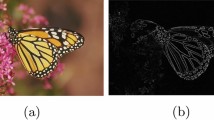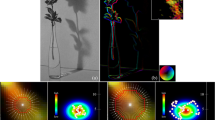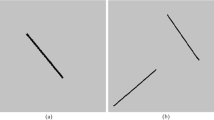Abstract
A new method to assess the presence and the strength of the blurring artifact in video frames, without using a reference ideal image, is presented. The estimation is performed first through a global and simple measure over the whole picture, then through a finer, local analysis of the sharpness of the objects borders. The subjective relevance of the scene content is accounted for in choosing the image parts where this local blurriness measurement is performed. Relevant parts are selected using an existing measurement of the saliency of each pixel as well as a simple method to detect human faces, which are a particularly attracting content for the viewer. In the so selected parts, an objective measurement of the blurriness artifact is performed, based on the presence of fine detail and on the local edge width. Then the scene activity, or clutter, is measured by counting the number of distinct picture regions. In an active scene, indeed, a blurred object is deemed to be less apparent. The combination of quantified objective blurriness with clutter yields a final index, which proved to appropriately reproduce the judgements of human observers on images of different quality, resulting from different video encodings.
Similar content being viewed by others
References
Babu, R.V., Perkis, A.: An hvs-based no reference perceptual quality assessment of jpeg coded images using neural networks. In: Proceedings of IEEE International Conference on Image Processing, pp. 433–436 (2005)
Bogdanova I., Bur A., Hngli H.: Visual attention on the sphere. IEEE Trans. Image Process. 17, 2000–2014 (2008)
Bravo M., Farid H.: A scale invariant measure of clutter. J. Vis. 23, 1–9 (2008)
Carnec M., Le Callet P., Barba D.: Objective quality assessment of color images based on a generic perceptual reducedreference. Signal Process. Image Commun. 4, 239–256 (2008)
Cavallaro, A., Winkler, S.: Segmentation-driven perceptual quality metric. In: Proceedings of IEEE International Conference on Image Processing, pp. 3543–3546 (2004)
Caviedes, J., Gurbuz, S.: No reference sharpness metric based on local edge kurtosis. In: Proceedings of IEEE International Conference on Image Processing, pp. 53–56 (2002)
Chai D., Ngan K.: Face segmentation using skin-color map in videophone applications. IEEE Trans Circuits Syst. Video Technol 9, 551–564 (1999)
Doom9’s forum, MeGUI Custom x264/AVC video profiles (2009). http://forum.doom9.org/showthread.php?t=101813, last check the 28 April 2009
Farias, M., Mitra, S.: No-reference video quality metric based on artifact measurements. In: Proceedings of the IEEE International Conference on Image Processing, vol. 3, pp. 141–144 (2005)
Felzenszwalb P., Huttenlocher D.: Efficient graph-based image segmentation. Int. J. Comput. Vis. 59, 167–181 (2004)
Ferzli R., Karam L.: A no reference objective image sharpness metric based on the notion of just noticeable blur (jnb). IEEE Trans. Image Process. 18, 717–728 (2009)
Final report from the video quality experts group on the validation of objective models of video quality assessment. VQEG Report COM 9-80-E (2000). Online available http://www.vqeg.com
Itti L., Koch C., Niebur E.: A model of saliency-based visual attention for rapid scene analysis. IEEE Trans. Pattern Anal. Mach. Intell. 20, 1254–1259 (1998)
Koch C., Ullman S.: Shifts in selective visual attention: towards the underlying neural circuitry. Hum. Neurobiol. 4, 219–227 (1985)
Marichal, X., Ma, W., Zhang, H.: Blur determination in the compressed domain using dct information. In: Proceedings of IEEE International Conference on Image Processing, pp. 386–390 (1999)
Marziliano, P., Dufaux, F., Winkler, S., Ebrahimi, T.: A no reference perceptual blur metric. In: Proceedings of IEEE International Conference on Image Processing, pp. 57–60 (2002)
Oelbaum T., Keimel C., Diepold K.: Rule-based no-reference video quality evaluation using additionally coded videos. IEEE J. Sel. Top. Signal Process. 3, 294–307 (2009)
Perona P., Malik J.: Scale-space and edge detection using anisotropic diffusion. IEEE Trans. Pattern Anal. Mach. Intell. 12, 629–639 (1990)
Ramanarayanan G., Bala K., Ferwerda J.: Perception of complex aggregates. IEEE J. Sel. Top. Signal Process. 3, 294–303 (2009)
Shao L., Zhang H., de Haan G.: An overview and performance evaluation of classification-based least squared trained filters. IEEE Trans. Image Process. 17, 1772–1782 (2008)
Sheikh H., Bovik A., Cormack L.: No-reference quality assessment usingnatural scene statistics: Jpeg2000. IEEE Trans. Image Process. 14, 1918–1927 (2005)
Wang, Z., Sheikh, R., Bovik, A.: No reference perceptual quality assessment of jpeg compressed images. In: Proceedings of IEEE International Conference on Image Processing, pp. 477–480 (2002)
Wu H., Yuen R.: A generalized block-edge impairment metric for video coding. IEEE Signal Process. Lett. 4, 317–320 (1997)
Yang, J., Lu, W., Waibel, A.: Skin-color modeling and adaptation. In: Asian Conference on Computer Vision, vol. 2, pp. 687–694 (1998)
Yang F., Wan S., Chang Y., Wu H.R.: A novel objective no-reference metric for digital video quality assessment. IEEE Signal Process. Lett. 12, 685–688 (2005)
Author information
Authors and Affiliations
Corresponding author
Rights and permissions
About this article
Cite this article
Dardi, F., Abate, L. & Ramponi, G. No-reference measurement of perceptually significant blurriness in video frames. SIViP 5, 271–282 (2011). https://doi.org/10.1007/s11760-010-0198-0
Received:
Revised:
Accepted:
Published:
Issue Date:
DOI: https://doi.org/10.1007/s11760-010-0198-0




